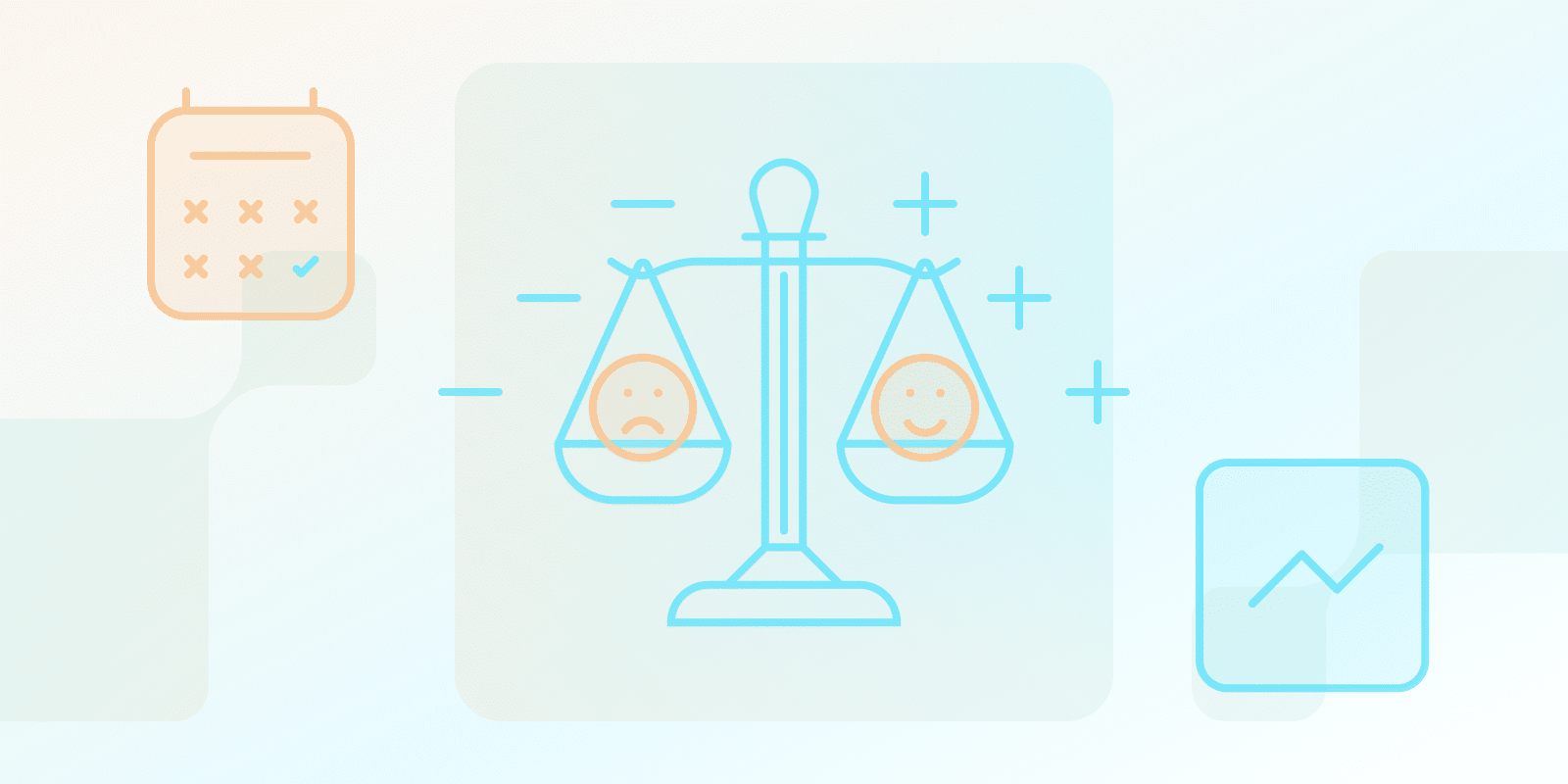Wskaźniki i KPI dla SaaS
Czym są dni do osiągnięcia progu rentowności?

Czym są dni do osiągnięcia progu rentowności?
Termin “dni do osiągnięcia progu rentowności” odnosi się do czasu, jaki zajmuje firmie pokrycie wszystkich wydatków i rozpoczęcie osiągania zysków.
Jest to szczególnie ważne dla firm świadczących usługi, takie jak malowanie domów lub doradztwo, które są ściśle związane z godzinami rozliczeniowymi klientów. Firmy mogą wykorzystać tę metodę do oszacowania liczby godzin rozliczeniowych wymaganych do pokrycia kosztów i rozpoczęcia osiągania zysków, co pomoże im wydajniej zarządzać obciążeniem pracą.
Szacunki progu rentowności opierają się na określonych założeniach i nie uwzględniają nieprzewidzianych zdarzeń, które mogą mieć wpływ na sprzedaż lub wydatki.
Czym jest punkt progu rentowności (BEP) w biznesie?
Wolumen sprzedaży lub poziom produkcji, przy którym całkowite przychody są równe całkowitym kosztom, a nie ma ani zysku, ani straty, jest znany jako punkt równowagi (BEP) w biznesie. Dla organizacji punkt rentowności jest istotną statystyką finansową, ponieważ ustala minimalny poziom wydajności potrzebny do zapobiegania stratom.
Znajomość progu rentowności może pomóc firmom podejmować świadome decyzje dotyczące ceny, poziomów produkcji i efektywności operacyjnej. Należy jednak pamiętać, że punkt rentowności jest jedynie wartością teoretyczną, a rzeczywista rentowność może się różnić w zależności od innych czynników, takich jak panujące warunki rynkowe.
Jak oblicza się punkt rentowności?
Gdy cały przychód i całkowite koszty są równe, nie ma zysku ani straty, co jest znane jako punkt rentowności. Firmy muszą znać tę liczbę, ponieważ mówi im, ile więcej muszą sprzedać, aby osiągnąć próg rentowności i zacząć osiągać zysk.
Oto metoda obliczeniowa:
Jednostki dla punktu równowagi:
Cena sprzedaży za jednostkę - Zmienne koszty za jednostkę = Stałe koszty ÷Punkt równowagi w dolarach dla sprzedaży:
Stałe koszty ÷ Marża wkładu, gdzie marża to:
(Cena sprzedaży za jednostkę - Zmienne koszty za jednostkę) ÷ Cena sprzedaży za jednostkę
Podzielmy składniki:
- Koszty stałe: Wydatki (takie jak czynsz, wynagrodzenie i ubezpieczenie), które pozostają stałe niezależnie od wielkości produkcji.
- Koszty, które zmieniają się w zależności od wielkości produkcji, są znane jako koszty zmienne (np. surowce, praca bezpośrednia).
- Koszt, po którym każda jednostka jest sprzedawana, jest znany jako cena sprzedaży za jednostkę.
Na przykład:
Załóżmy, że prowadzisz firmę produkującą koszulki. Masz 1000 USD stałych wydatków miesięcznie, 5 USD zmiennych kosztów na koszulkę i 20 USD przychodu z każdej sprzedanej koszulki.
Jednostki potrzebne do osiągnięcia progu rentowności: 1000 USD ÷ (20 USD - 5 USD) = 66,67 jednostek. Aby osiągnąć próg rentowności, musisz sprzedać około 67 koszulek.
Marża brutto: (20 USD - 5 USD) ÷ 20 USD = 0,75 lub 75 procent.
W dolarach sprzedaży próg rentowności wynosi 1000 USD ÷ 0,75 = 1333,33 USD. Aby osiągnąć próg rentowności, musisz uzyskać 1333,33 USD przychodów ze sprzedaży.
Jak mogę przewidzieć harmonogram osiągnięcia progu rentowności dla mojej firmy?
Pierwszym krokiem w oszacowaniu punktu rentowności jest ustalenie stałych kosztów. Obejmuje to wszystkie koszty firmy, które są stałe niezależnie od produkcji lub sprzedaży, takie jak czynsz, wynagrodzenia i media.
Następnie określ zmienne koszty. Są to koszty takie jak praca, materiały i wysyłka, które zmieniają się w zależności od wolumenu sprzedaży lub produkcji.
Określ swoją marżę brutto, odejmując zmienne koszty od ceny sprzedaży. To jest kwota pieniędzy, którą zarabiasz. Twój całkowity przychód i całkowite koszty muszą się zrównoważyć, aby osiągnąć próg rentowności.
Można zastosować następujące obliczenie: Marża brutto na jednostkę / Koszty stałe = Próg rentowności (jednostki).
Wprowadź niezbędne korekty w harmonogramie na podstawie realistycznych prognoz sprzedaży.
| Komponent | Wpływ na biznes | Metoda kalkulacji |
|---|---|---|
| Struktura kosztów | ||
| Koszty stałe | Stałe niezależnie od wielkości produkcji | Suma czynszu, płac, mediów, ubezpieczenia itp. |
| Koszty zmienne | Zmieniają się wraz z wielkością produkcji | Surowce + bezpośrednia robocizna + wysyłka na jednostkę |
| Składniki przychodu | ||
| Cena sprzedaży jednostkowej | Bezpośrednio wpływa na marżę zysku | Cena rynkowa – rabaty |
| Marża kontrybucyjna | Wskazuje potencjał zysku na jednostkę | (Cena sprzedaży – Koszty zmienne) / Cena sprzedaży |
| Obliczanie progu rentowności | ||
| Próg rentowności (jednostki) | Minimalna liczba jednostek potrzebna do osiągnięcia zerowego zysku/straty | Koszty stałe / (Cena sprzedaży – Koszty zmienne) |
| Próg rentowności (sprzedaż) | Minimalny przychód potrzebny do osiągnięcia zerowego zysku/straty | Koszty stałe / Marża kontrybucyjna |
Czym jest analiza progu rentowności w biznesie?
W świecie biznesu badanie progu rentowności ustala punkt krytyczny, w którym całkowite przychody i całkowite koszty się równoważą, wskazując punkt, w którym przedsięwzięcie, oferta lub przedmiot przynosi zysk. Wpływa to na wybory dotyczące plan cenowy i produkcji poprzez ocenę ryzyka i możliwych korzyści z wydatków korporacyjnych.
Dzięki analizie progu rentowności można określić przychód wymagany do pokrycia stałych i zmiennych kosztów, a także punkt progu rentowności. Pamiętaj, że zysk pojawia się tylko wtedy, gdy przychód przekracza sumę wszystkich stałych i zmiennych kosztów.
Wniosek
Firmy muszą zrozumieć ideę progu rentowności, aby monitorować swoje wyniki i podejmować mądre decyzje dotyczące ceny, produkcji i efektywności operacyjnej. Firmy mogą znaleźć minimalną wielkość sprzedaży lub przychody wymagane do pokrycia swoich kosztów i rozpoczęcia osiągania zysku, określając punkt progu rentowności.
Chociaż analiza progu rentowności jest użytecznym narzędziem do planowania finansowego, należy pamiętać, że opiera się ona na założeniach i może nie uwzględniać nieprzewidzianych zdarzeń.